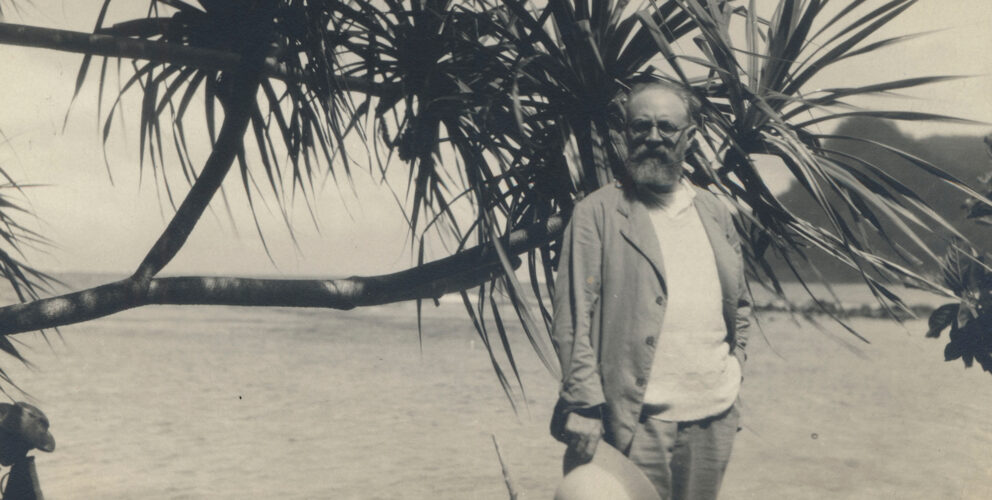Matisse working at the Hotel Regina, Nice, c. 1952; © 2024 Succession H. Matisse / Artists Rights Society (ARS), New York, Photo by Walter Carone / Paris Match via Getty Images
During his lengthy career, Henri Matisse worked across various media, including paintings, drawings, prints, sculptures, and ceramics. However, his most innovative work came in the last decades of his career, when he developed a technique using cut pieces of colored paper to build vibrant and sometimes massive compositions. These works combined aspects of his other art forms: the intense colors of his paintings, the three-dimensionality of his sculptures, and the distinct contours of his drawings.
In Henri Matisse: Paper Cut-Outs, art historian Jack Cowart notes that Matisse had been utilizing the cut-out technique as a design tool for many years, to plan large scale murals and decorations as well as to work out compositions before painting them. But by the mid-1930s, Matisse also began to consider the expressive potential of cut and colored paper as works of art in their own right.

Henri Matisse, French, 1869–1954; Blue Nude I, 1947; gouache, painted paper cut-outs on canvas; 41 7/8 x 30 11/16 inches; Foundation Beyeler Collection, Inv.60.1; © 2024 Succession H. Matisse / Artists Rights Society (ARS), New York
In Matisse the Master. A Life of Henri Matisse: The Conquest of Color, 1909-1954, Matisse’s biographer Hilary Spurling describes a decisive turning point that came in 1940, when Matisse fell gravely ill. Following abdominal surgery early in 1941, plus an extensive recovery period, Matisse finally returned to his studio in Nice that spring with a renewed urge to work. But in his weakened state, he was physically unable to paint or sculpt. He turned back to paper cut-outs, this time as standalone works of art.
Curator Jodi Hauptman of the Museum of Modern Art described Matisse’s creative process in the 2014 exhibition catalogue Henri Matisse: The Cut-Outs. Studio assistants, such as Lydia Delectorskaya and Paule Caen-Martin, played important roles in the process. They would present him with colorful sheets of paper that they had pre-painted with gouache, a kind of opaque watercolor. Matisse would select a sheet and a pair of scissors or shears, then cut abstract forms from the paper. His assistants would hold the paper and turn or rotate it for Matisse as he cut, allowing him to create smooth curving contours for the cut form. In her catalogue essay, Hauptman noted each cutting produced a positive and a negative form—the cut piece and the leftover cut paper—and Matisse frequently made use of both pieces in his works.

Henri Matisse, French, 1869–1954; Composition Green Background, 1947; gouache, cut papers and pencil on paper; 41 x 15 7/16 inches; The Menil Collection, Houston; © 2024 Succession H. Matisse / Artists Rights Society (ARS), New York, Photographer: Hickey-Robertson, Houston
Once the components were cut, they would be pinned to either a paper support or directly to the walls. Pinning the paper allowed Matisse to continue to work with the pieces, arranging and rearranging them. When he was satisfied with a form’s placement, he would carefully note its location, remove the pins, and glue it down. These notations often remained part of the final artwork; for example, in the cut-out piece Composition with Green Background, on view currently in Matisse and the Sea, pencil marks are still visible throughout. Likewise, viewers can also still see the pin holes on the cut forms.
Matisse’s larger cut-out compositions were pinned to his walls, and could remain there for months or years as he continued to work with them. These often-massive works surrounded the artist in the studio, creating a fantasy environment. In his essay “Matisse and Water” in the exhibition catalogue for Matisse and the Sea, John Klein compares these immersive spaces to Matisse’s experience of literally immersing himself in the lagoons of French Polynesia, where he traveled in 1930. And though Matisse sometimes described his studio space as a “garden,” Klein notes the overwhelming presence of aquatic imagery in the cut-outs from this time. This is apparent in a photograph from 1946 showing the original cut-outs of Oceania, The Sky and Oceania, The Sea in the corner of his Paris apartment. These cut-outs were designs for textile wall-hangings that were made by screenprinting the forms onto beige linen. Both Oceania textiles are currently on view in Matisse and the Sea.

Matisse's studio, Paris, with the cut-outs Oceania, the Sky and Oceania, the Sea joined by a band above the doorway; © 2024 Succession H. Matisse / Artists Rights Society (ARS), New York, Photograph by Helene Adant
Matisse began exhibiting his paper cut-outs as works of art soon after developing the technique, with cut-outs appearing in exhibitions beginning in 1948. As Simon Kelly notes in the exhibition catalogue for Matisse and the Sea, many critics reacted with hostility toward the new medium, even describing the works as “jokes.” But the cut-outs came to be celebrated in time and are widely regarded as some of his most innovative works.
The Saint Louis Art Museum has an important connection with Matisse’s cut-outs, as it spearheaded a major retrospective on that part of Matisse’s oeuvre in 1977 and 1978. Henri Matisse: Paper Cut-Outs was organized by former Saint Louis Art Museum curator Jack Cowart, with former curator John Hallmark Neff at the Detroit Institute of Arts.

Gallery view, 1978, Henry Matisse: Paper Cut-Outs Exhibition Photographs, Saint Louis Art Museum Archives; © 2024 Succession H. Matisse / Artists Rights Society (ARS), New York
It represented one of the earliest and most comprehensive studies of Matisse’s cut-out technique. This remarkable exhibition brought together more than 50 of the artist’s cut-outs, including a wide range of different projects, in addition to independent works. In an exhibition review by Jane Hallett in The Observer from February 15, 1978, Cowart described the process of bringing the exhibition to fruition, including discovering 20 cut-outs that had not been known to exist. The exhibition opened at the National Gallery of Art in Washington, D.C., in the fall of 1977, then traveled to Detroit, before finally coming to St. Louis in January 1978. The Observer quoted Cowart as saying the St. Louis installation was the best of the three.
Several of Matisse’s paper cut-outs and designs are featured in Matisse and the Sea. The exhibition is on view from February 17 through May 12, 2024.

